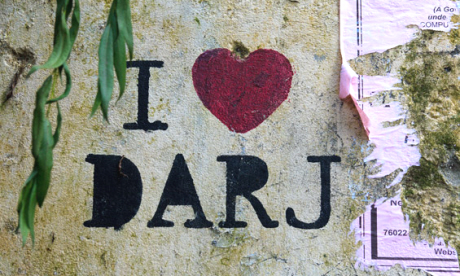
You don't have to spend a king's ransom to live like royalty in the "Queen of Hills". This beautiful Indian hill station has plenty to offer travellers on a shoe string too
Darjeeling stretches across the towering mountainside, a jumble of Victorian buildings jostling for position with modern concrete boxes. There are some wide roads, but most of the town is an organic series of passages, lanes and alleyways. Put on your walking boots for the best way to absorb the atmosphere and to meet people. Steep stone and wooden steps thread their way up and down through the market area, while wide roads, flanked by buildings straight from Hampstead Heath, traverse the top of the town.
Known as the "Toy Train" because of its two foot narrow gauge track, the Darjeeling railway is still considered by UNESCO to be "the most outstanding example of a hill passenger railway" in the world.
You can experience the ancient steam train as it hoots, hisses and chug-a-lugs its way round the mountain on a half day return journey from Darjeeling to Ghum. Called the "joy ride", the journey includes the Batasia loop, where the train stops for passengers to admire the view and pay homage to the Gorkha War Memorial.
Tickets cost 360 Rupees (around £4.20 or $6.50) and include entry to the railway museum in Ghum.
When the Dalai Lama fled Tibet in 1959, he sparked an exodus as thousands of his compatriots followed him. Since then, the Tibetan Self Help Refugee Centre in Darjeeling has evolved into one of the most important enclaves of the Tibetan diaspora.
This community, set on a hilltop above vertical tea gardens, houses its own school and gompa (monastery) and provides shelter for both young and old. A series of craft work shops surrounds the central courtyard, including tailors, leatherworkers, illustrators, knitters and more. There is a successful separate carpet weaving centre where you are encouraged to watch the artisans at work and an on-site shop.
Free to visit from dusk till dawn.
Dedicated to the conservation of endangered Himalayan species, the Padmaja Naidu Himalayan Zoological Park is built on the mountainside, where its steep enclosures mimic the inhabitants' natural habitat. Look for red pandas, Tibetan wolves, Himalayan black bears, the beautiful clouded leopard and other big cats. Set within the same grounds of the zoo, the Mountain Institute is a training centre for mountaineering. It also houses a museum.
Open daily from 8am to 4pm. The admission ticket covers both attractions.
Sample the elegant life of a 19th century hill station at the Windamere Hotel. Built as a boarding house for well to do British tea planters, the rooms are crammed with old photos, works of art and antique furniture. Have a drink in front of the fire in the evening, or out in the garden on a sunny day. Try a pot of Darjeeling's finest, or splash out on a glass of beer or good wine. You'll only be able to afford one.
Packed from the minute it opens, this strictly vegetarian cafeteria delivers exactly what it promises: fast, delicious food. It is also frenetic, hectic and loud. A vast menu is displayed above a long counter. Place your order, grab a piece of paper with a number scribbled on it, and see if you can bag a table by the window.
As you wait for the waiter to call your number, you can gaze across the valley at Khangchendzonga. If you've had enough of mountains (is that possible?) some people watching is in order: a cavalcade of characters swiftly passes through, mainly cold-looking domestic Indian tourists in idiosyncratic get-ups (the women in bejewelled, kitten heeled sandals, the men in extravagant bobble hats and tight gilets).
A typical meal of two enormous bowls of (veg) chow mein and two lassis costs 120Rs (around £1.50 or $2.20).
Address: 13, Nehru Road
In many places local initiatives are springing up to empower the invisible women of India. Hayden Hall was set up in 1969 with the purpose of helping women towards self sufficiency through education and training. Show your support by buying something from the shop: the handwoven carpets and bags, or knitted hats and socks are particularly beautiful, and your money goes straight back into the charity.
Colourful Chowrasta is a magnet for all visitors to Darjeeling. But walk just a little higher from its busy square to nearby Observatory Hill for a great view across the valleys. Originally where the Bhutia Busty Gompa stood, it is still home to the Hindu Mahakal temple and is an area of significance to both religions.
As the mystical hill rings with the sound of temple bells, lose yourself among the prayer flags, but watch out for groups of boisterous monkeys who have made it their home.
Buddhist monasteries, known as gompas, are the centre of many communities in this part of the Himalayas. There are several in and around Darjeeling, so take a day out to visit some of them. Under the watchful eye of Khangchendzonga, beautiful Bhutia Busty Gompa, not far from Chowrasta, is home to the original copy of the Tibetan Book of the Dead.
Join the early morning exodus to Tiger Hill to catch the sun's first rays as they hit the distant snow caps of the Khangchendzonga massif. If it's a really clear day you may even see Everest. Pick up a shared Jeep at 4.30am, then join the bun fight for the best position on the observation post at Tiger Hill, just above Ghum. Even if it's foggy in Darjeeling it may be clear higher up, and the visibility can change in the blink of a camera shutter.
10 things to do for free in Kolkata | Inspire me... More
21 great Himalaya adventures | Inspire me.. More
7 rural recipes from India | Inspire me... More
10 tips for a trip to Kochi, India | Inspire me... More
Insider Secrets: 3 forgotten Himayalan gems | Blogs... More